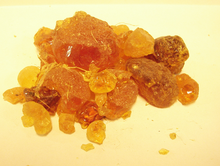Gum arabic. Closely related to gum acacia.
- botanical information
- origin
- history
- part used
- astrological correspondences
- magick correspondences and uses
- Goddesses and deities
- health care
- traditional Western medicine
- external skin care
- cautions and contraindications
botanical information:
Botanical name: Acacia vera
Common name: Arabic gum, Egyptian gum, Egyptian thorn, gum arabic, Indian gum
Use the botanical name when ordering seeds (bulbs, etc.) or when looking up information in the library. Common names vary by nation, culture, and region, and sometimes the same common name is applied to different plants.
The tree that produces gum arabic is of the same genus (related species) as the tree that produces gum acacia and sometimes these two gums are interchangeably labelled.
Family: Fabaceae (bean)
Height: mostly shrubs; can be trees normally 8-12 feet; can grow up to 40 feet
Flower: bright yellow
origin:
Origin: Egypt, Arabia, north Africa, west Asia
history:
History: Grown from antiquity in Egypt, Arabia, and west Asia.
ancient Egypt: Both the wood and the gum were used for a wide variety of purposes. The gum was used for spiritual prurposes, especially in making religious and magickal incenses.
ancient Egypt: Wood used for roof timbers of up to 12 cubits length. The wood was also used for the main timbers of the ribs and hulls for small ships. Short pieces of wood were used for the common Nile Cargo Barque (small pieces of wood fitted together). Wood also used for furniture, chests, coffins, and bows.
part used:
part used: wood and sap (the gum is made from the sap)
astrological correspondences:
Astrological planet: Sun ![]()
magickal correspondences and uses:
Month: associated with Spring time months, especially the Vernal or Spring equinox.
Gender: masculine (traditional western European magickal gender)
Western element: air
Magickal uses: burn for altar offerings, clairvoyance, protection, spiritual use
Magickal uses: the gum is used for making magickal incenses
Magickal uses: Burn with sandalwood during meditattion to seek enlightenment and develop psychic powers.
Magickal uses: The wood of the bush or tree can be formed into a protection amulet.
Solar spells: Gum Arabic (as an herbal gum) may be used in as an ingredient or substitute for magick spells and formulas related to solar matters (healing, illumination, magickal power, physical energy, protection, success, and putting an end to legal matters). Be careful about substitutions for preparations that will be ingested or come in contact with the skin. These substitutions do not apply to medical uses. See the article on the Sun for a list of herbal substitutes for Arabic gum.
Magickal substitutions: Gum Arabic may be safely substituted for acacia or gum acacia in magick spells and rituals.

Magical Uses information courtesy of 
|
deities associated with gum Arabic:
- Asar (Kemetic/ancient Egyptian deity)
- Astarte (Hebrew Goddess)
- Astarte (Phoenician Goddess)
- Diana (Roman Goddess)
- Ishtar (Babylonian Goddess)
- Osiris (Kemetic/ancient Egyptian deity)
health care uses:
Health Notice: Attempting to be an amateur doctor is potentially dangerous to your health. This web page is not professional medical advice. Nothing on this website should be considered as a substitute or replacement for professional medical advice. Persons should seek the advice of qualified health providers. Self-medication should not be used as a substitute for professional medical care. Please confirm all self-medication with your doctor or health care professional. See the article on healing for recommended healers.
traditional medicine:
Traditional Medicine: While many traditional practices have been scientifically verified, some are now known to be dangerous. Seek the advice of qualified health care providers.
Gum Arabic has traditionally been used for soothing inflamed or irritated mucous surfaces by protecting them from irritants in the air.
Gum Arabic is edible.
Gum used to soften the skin.
Burns High tannic acid content helped protect and soothe burned skin.
Ulcers Astringent effect helped with slow discharge of puss and was used especially for ulcers in the mouth or on the gums.
Loose teeth Gum was boiled in water and the resulting mucilage used to temporarily hold loose teeth in place until the gum could heal.
Diarrhea Used to help ease the pain of diarrhea by coating the intestines and bowels. Either drank or delivered by enema. Commonly used for those with dysentary
Cough Used as a cough medicine.
external care:
External skin care: Gum traditionally used to soothe and soften the skin.
cautions and contraindications:
Cautions and contraindications: Arabic gum is believed to be safe.
Wild gathering: Avoid wild gathering. Some plants are endangered species. Please grow your own herbs in your own goddess garden (or window boxes).
next gum
herbs |
||
| previous plant |
next plant |















